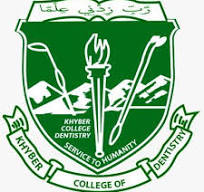CORRELATION BETWEEN NUMBER OF MISSING TEETH AND ORAL HEALTH RELATED QUALITY OF LIFE. A CROSS-SECTIONAL STUDY
DOI:
https://doi.org/10.33279/jkcd.v15i01.875Keywords:
Partial edentulisim, Missing teeth, Oral health related quality of life, General Oral Health Assessment IndexAbstract
Objectives: To determine correlation between number of missing teeth and Oral Health Related Quality of Life.
Materials and Methods: This study was carried out in the department of Prosthodontic, Khyber College of Dentistry, Peshawar. A non-probability consecutive sampling technique was used. A total of 177 partially edentulous patients were selected following strict inclusion and exclusion criteria. Data were collected using the method of interview. General Oral Health Assessment Index questionnaire was used as a tool for measurement of Oral Health Related Quality of Life. Number of missing teeth was determined through intra-oral examination. Pearson’s correlation and Linear Regression analysis was used to determine correlation and strength of association between number of missing teeth and General Oral Health Assessment Index score. A P < 0.05 was considered statistically significant.
Results: Out of 177 patients 49.7% were males and 50.3% were females. Means age of the patients was 35.8 (± 5.83). Average General Oral Health Assessment Index score for Oral Health Related Quality of Life was 47.82. Number of missing teeth was strongly related negatively with General Oral Health Assessment Index score, r= −0.53, p=<0.001. Linear regression analysis showed beta coefficient of −1.02 [CI = 95% (−1.24 to −0.79)].
Conclusion: Increase in number of missing teeth was strongly correlated negatively with Oral Health related Quality of life.
References
Dorri M, Sheiham A, Tsakos G. Validation of Persian version of the OIDP Index. BMC Oral Health 2007;7: 2-9. DOI: https://doi.org/10.1186/1472-6831-7-2
Hassel AJ, Rolko C, Koke U et al. A German version of GOHAI. Community Dent Oral Epidemiol 2008;36:34-42. DOI: https://doi.org/10.1111/j.1600-0528.2007.00351.x
Al Shamrany M. Oral health related quality of life: a broader perspective. La Revue de Santé de la Méditerranée orientale 006;12(7):894-901.
Locker D, Matear D, Stephens M et al. Oral health-related quality of life of a population of medically compromised elderly people. Community Dent Health 2002; 19: 90–7.
Astrøm AN, Haugejorden O, Skaret E et al. Oral impacts on daily performance in Norwegian adults: The influence of age, number of missing teeth, and socio-demographic factors. Eur J Oral Sci 2006; 114:115–21. DOI: https://doi.org/10.1111/j.1600-0722.2006.00336.x
Dable RA, Nazirkar GS, Singh SB, WasnikPB. Assessment of Oral Health Related Quality of life Among Completely Edentulous patients in Western India by using GOHAI. J Clinical & Diagnostic Research 2013;7(9):2063-7. DOI: https://doi.org/10.7860/JCDR/2013/6377.3406
Deshmukh SP, Radke UM. Translation and validation of the Hindi version of the Geriatric Oral Health Assessment Index. Gerodontology 2012;30:1-7. DOI: https://doi.org/10.1111/j.1741-2358.2011.00609.x
Tubert-Jeannin S, Riordan PJ, Morel-Papernot et al.Validation of oral health related quality of life index (GOHAI) in France. Community Dent Oral Epidemiol. 2003;31:275-84. DOI: https://doi.org/10.1034/j.1600-0528.2003.t01-1-00006.x
Nicolas E, Veyrune JL. A six month assessment of oral health-related quality of life of complete denture wearers using denture adhesives. J Prosthodont 2010;19:443-8. DOI: https://doi.org/10.1111/j.1532-849X.2010.00601.x
Othman WN, Muttalib KA, Bakri R et al. Validation of the Geriatric Oral Health assessment Index (GOHAI) in Malay Language. J Public Health Dent 2006;66(3):199-204. DOI: https://doi.org/10.1111/j.1752-7325.2006.tb02580.x
Dan WA, Qi LJ. Factors associated with oral health- related quality of life in elderly persons in dental clinic: validation of Mandarin Chinese version of GOHAI. Gerodontology 2011;28:184-91. DOI: https://doi.org/10.1111/j.1741-2358.2009.00360.x
Daradkeh S, Khader YS. Tranlation and validation and Arabic version of Geriatric Oral Health Assessment Index (GOHAI). J Oral Sci 2008;50:453-9. DOI: https://doi.org/10.2334/josnusd.50.453
Hagglin C, Berggren U, Lundgren J. A Swedish version of the GOHAI index. Psychometric properties and validation. Swed Dent J 2005; 29: 113–124.
Wong MC, Liu JK, Lo EC. Translation and validation of the Chinese version of GOHAI. J Public Health Dent 2002; 62: 78–83. DOI: https://doi.org/10.1111/j.1752-7325.2002.tb03426.x
Khan SU, Ghani F, Nazir Z. The effect of some missing teeth on a subjects’ oral health related quality of life. Pak J Med Sci.2018;34(6):1457-62. DOI: https://doi.org/10.12669/pjms.346.15706
Ghani F, Khan M. Missing teeth, edentulous areas and socio-demographic status adversely affect the quality of life. J Pak Dent Assoc 2010;19:05-14
Singh V, Singh R, Jyoti A, Sahu SK, Khan M, Kumar A. The Relationship Between Conventional Prosthesis Wearing and Geriatric Oral Health Assessment Index in Garhwa Town, Jharkhand. Int J Dent Med Res 2014;1(3):24-9.
Rusin MG, Koczorowski R, Sielska J. Linguistic adaptation and validation of the Polish version of the General Oral Health Assessment Index (GOHAI). J Stoma 2014; 67, 2: 152-65. DOI: https://doi.org/10.5604/00114553.1092259
Atieh MA. Arabic version of geriatric oral health assessment index. Gerodontology 2008;25:34-41. DOI: https://doi.org/10.1111/j.1741-2358.2007.00195.x
Inukai M, John MT, Igarashi Y, Baba K. Association between perceived chewing ability and oral health-related quality of life in partially dentate patients. Health and Quality of Life Outcomes 2010, 8:118-24. DOI: https://doi.org/10.1186/1477-7525-8-118
Mohamad Fuad MA, Yacob H, Mohamed N, Wong NI: Association of sociodemographic factors and selfperception of health status on oral health-related quality of life among the older persons in Malaysia.Geriatr Gerontol Int. 2020, 20:57-62. DOI: https://doi.org/10.1111/ggi.13969
Downloads
Published
How to Cite
Issue
Section
License
Copyright (c) 2025 Shafi Ullah Khan, Faiza Abdulhakam, Ehtesham Khan Shami, Malika Rehman

This work is licensed under a Creative Commons Attribution-NonCommercial 4.0 International License.
You are free to:
- Share — copy and redistribute the material in any medium or format
- Adapt — remix, transform, and build upon the material
- The licensor cannot revoke these freedoms as long as you follow the license terms.
Under the following terms:
- Attribution — You must give appropriate credit , provide a link to the license, and indicate if changes were made . You may do so in any reasonable manner, but not in any way that suggests the licensor endorses you or your use.
- NonCommercial — You may not use the material for commercial purposes .
- No additional restrictions — You may not apply legal terms or technological measures that legally restrict others from doing anything the license permits.










